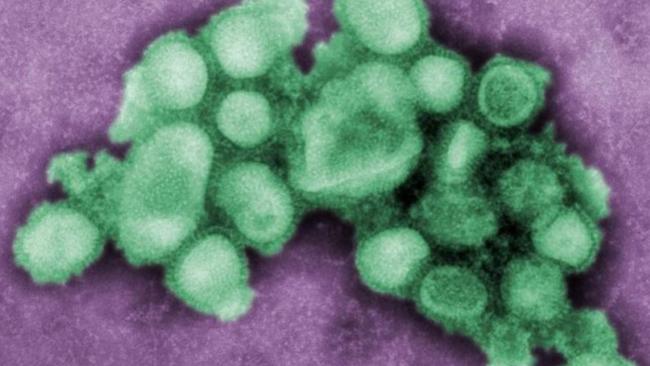Sydneysiders in their thousands struck down by spikes in flu and gastro
A PERFECT storm is fuelling a huge spike in flu and gastro cases in Sydney which has struck down thousands of people.
HAVE you been off work recently? Knocking back the Lemsip? Or even wrapped around the toilet bowl?
Well, if you’re a Sydneysider you’re not alone. In fact the whole city is in the midst of an illness crisis with a sharp rise in the number of flu cases over last year and thousands struck down with gastroenteritis in the last week alone.
It’s a city with a collective snotty nose and upset belly.
“There’s a saying that goes ‘if you’ve seen one flu season, you’ve seen one flu season’,” Kim Sampson, CEO of the Immunisation Coalition told news.com.au.
“In terms of flu, in sheer numbers, now it’s NSW”.

It’ll come as no surprise that the chilly winter nights may be partly to blame. What may be more surprising, however, is that this winter’s lack of rain may also have played a role.
Far from soggy conditions helping a virus do its worse, the opposite is true in most parts of Australia. The cold and dry Sydney weather is creating the prefect storm to rev up the virus.
And flu watchers have said it’s not just kids and the elderly that have to watch out, younger, healthier people are being whacked hard this year too.
It could end up being the worst flu season on record.

MARKED INCREASE IN FLU, GASTRO
On Thursday, NSW Health said there was a 34 per cent increase in viral gastroenteritis notifications across the state over the previous year.
More than 1900 people had attended NSW emergency departments with gastro in the past week alone — more than 400 of those admitted to hospital.
Coupled with that, NSW Health has also said there had been a “marked increase” in presentations to emergency departments for pneumonia and influenza-like illnesses including 53 critical care admissions up to 30 July.
More than 11,000 influenza cases were reported in the state in July with a “spike” in aged care facilities, the Government department said.
“Each year more than 800 people die in NSW from complications associated with influenza,” said Dr Vicky Sheppeard the Director of the Communicable Diseases at NSW Health.
“We are seeing high levels of both influenza A and B strains circulating in the community and older people are more susceptible to severe infection from the influenza A strain that is circulating.”

FLU B HAS OVERTAKEN FLU A
It was unusual to see the flu B virus be so prevalent this early in the season, Dr David Muscatello, an epidemiologist at the University of New South Wales’ School of Public Health and Community Medicine, told news.com.au.
“Flu B usually starts later in the season after flu A but this year it started to pick up first.
“The strains affect people in different ways. Flu A has a larger impact on older people and younger children while flu B affects younger people more widely,” Dr Muscatello said.
With flu B out of the traps first this year, it’s left younger people more at risk earlier in the season to be struck down.
However, older people, with more health problems, are less able to shrug the virus off.
What makes one flu season fairly benign while another supercharged is still not fully understood by public health experts.

Dr Sampson said a mix of different strains in different areas was a factor.
“The virus that circulates varies so you may get a lot of B in one state, H1 in another, H3 in another.
“They can all be there but in different proportions and during the course of the year they can evolve and one strain can overtake another so it can be a moving feast.”
Another factor at play is climate with this year’s record dry winter across the south east coupled with some particularly cold nights in NSW leading to potentially prefect conditions for the influenza virus
“There is evidence to suggest cold and dry weather can be a factor in a flu season,” Dr Sampson told news.com.au.
“Melbourne is interesting as its season has not been too bad.
“Right now Melbourne is going through a cold patch and we’ve just had kids go back to school so we would expect numbers to be going up in Victoria,” he said.

FLU LOVES DRY WEATHER
“We’ve seen a very big jump in NSW and South Australia and now there’s quite a bit of activity in Victoria but in terms of sheer numbers it’s NSW”.
Flu season has also hit some 10,000 Queenslanders who have been struck down, with a fifth of those falling ill in the last week of July
Dr Muscatello said low temperatures of around 5C in conjunction with low humidity of 40 per cent of less were associated with airborne transmission of influenza.
Research published in 2013 by Columbia University found flu epidemics almost always followed a drop in air humidity.
The reason is that when you sneeze and expel masses of the virus, it finds it easier to travel if it doesn’t collide with big globules of moisture.
Humid air can drag the virus to the ground or even change its composition reducing its virility.
That’s not to say citizens of humid Far North Queensland and the Top End are flu free. Far from it, but the virus is more likely to be spread through touch than through the air.
The tendency of people to huddle together in winter and hang out indoors, such as in cinemas and pubs, can also gave the flu a boost.
“The virus is clever, it finds ways to transit itself,” said Dr Muscatello.
Despite the large early peaks in flu infections, it wasn’t a given this season would be worse than others, he said.
And while Sydney may be suffering now, there’s every possibility Melbourne could streak ahead in the snot stakes as winter takes its course.
NSW Health’s flu-free advice remains the same. Avoid ill people, crowded places and if you have the symptoms, don’t visit vulnerable people or aged care facilities
Cover your mouth when coughing or sneezing, use disposable tissues and wash your hands regularly.




